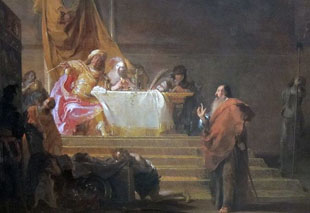The Croesus story from Herodotus Book 1 chapter 6 - 95 forms the ‘Lydios logos’, the basis for this final intermediate activity in the OpenLearn Herodotus Collection. We have selected sections for you to enquire into how Herodotus’ narrative is linked with places in the Classical world. You may like to explore the Timeline, included in this collection, to put some of the narratives in the context of other historical events from the period. The final part of this activity involves comparing Solon’s travels with travel in the area today.
 Solon, mosaic from Suweydie near Baalbek
Solon, mosaic from Suweydie near Baalbek
Solon is said to have been born in Athens around 638 BC. Stories about his life and works as a poet and lawmaker are based on tiny fragments of evidence, but he is considered by some to have laid the foundations for Athenian democracy. Certainly later Athenians (of the time of Herodotus’ ‘The Histories’) looked back to Solon as the founding figure of their radical experiment with people power.
Herodotus records that Solon made a ten-year journey, undertaken after implementing major reforms in Athens, to visit Cyprus and Egypt. The part of Herodotus' story where Solon meets Croesus is a fiction.
The journey itself may or may not have happened. It’s both a literary ‘topos’ related to the figure of the law-giver in Greek culture, and a reflection of a lot of real travel in the eastern Mediterranean by 6th century Greeks. Solon's reforms are conventionally dated to the first decade of the 6th century. Croesus, by Herodotus' chronology, was born in 595 BC. If Solon had undertaken his reforms, departed Athens, and then come to see him at the end of ten years, Croesus would have been at most a teenager, and not yet king.
In the ‘Lydios logos: the story of Croesus’ we ask not so much the ‘what’ questions eg ‘Did Croesus die in 547 BC?’ and ‘Did Solon visit him or not?’, but the ‘why’. 'Why did Herodotus include . . . ?' and 'What does that say about . . . ?' Take another look at this activity before reviewing the theme of ‘historical truth’ as you think about the fictitious meeting between Solon and Croesus described in the next extract.
We are told by Herodotus that Solon visits Croesus at Sardis and is asked by him ‘Who is the most fortunate man you have seen?’ Read Solon’s responses, which did not please Croesus at all. What can we take from Solon’s observations about happiness and good fortune in the light of political and social life today?
Journeying around the Mediterranean: then and now
 Solon before Croesus by Nicolaes Knupfer, c. 1650-52
Whether the adventure in Egypt is true or not, the story forms an interesting background to an activity where we can compare a journey from the 6th century BC with a similar Mediterranean adventure today. Solon travelled from Athens to Egypt (Aegyptus) where Herodotus notes he visited Sais, for an audience with the Pharaoh Amasis II.
Solon before Croesus by Nicolaes Knupfer, c. 1650-52
Whether the adventure in Egypt is true or not, the story forms an interesting background to an activity where we can compare a journey from the 6th century BC with a similar Mediterranean adventure today. Solon travelled from Athens to Egypt (Aegyptus) where Herodotus notes he visited Sais, for an audience with the Pharaoh Amasis II.
Other writers indicate he journeyed to Cyprus before travelling on to meet with Croesus in Sardis. Herodotus describes Amasis and the district of Sais. Explore the 16 references to Sais. Refer to 'Hestia map and project partners' resources' for guidance on using the HestiaVis map and texts.
Now use the ORBIS platform at Stanford to explore the time and cost of a journey from Athens to Egypt (Aegyptus), stopping in Cyprus, and on to Sardis. Although this project provides a model of the Roman world, the results are compatible with the earlier period.
Compare your results with a similar journey today, using Google maps alongside budget airline and travel operators’ sites, to work out the cost and time it would take. Research the ancient sites and compare them with their modern locations. Change some of the parameters offered on the Stanford map (conveyance, season etc.) to see how that affects the time the trip takes, how much it costs etc.
Browse amongst the Flickr photostreams to see what places look like, and who has visited them today.
Consider the impact of using digital maps such as those developed by the Hestia project on the results of your enquiry, research and understanding. The project team is interested in finding out how they may be improved to enhance study further. Send us a comment via the links below or contact us directly by email.








Rate and Review
Rate this activity
Review this activity
Log into OpenLearn to leave reviews and join in the conversation.
Activity reviews